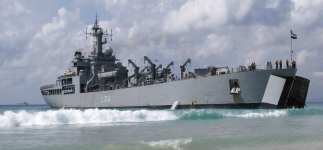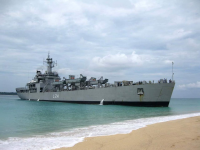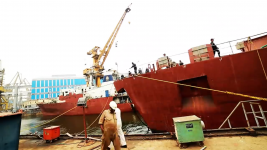There was a spate of accidents in the Navy at the port of Vishakhapatnam between late 2013 to early 2014. The accident were mostly caused by the then ongoing dredging work at the entry to the port channel (known as the Vizag channel).
In January 2014 INS Airavat (L24), the 3rd ship of the Shardul class amphibious tank landing ship, had an accident at the Vizag channel. INS Airavat was returning back to her home port after a patrol of the Bay of Bengal.
The media reported it a week later :
Another Navy ship damaged, hits bottom of Vizag channel
The Navy sacked the Commander of the ship & ordered a probe :
Navy removes INS Airavat captain JPS Virk for harbour mishap

The ship was fully loaded, thus floating lower, & seem to have carried a good amount of speed when it entered the port. One of its 2 propellers were hit by the debris from the dredging. The propeller got stuck, the engine kept rotating the shaft eventually twisting and bending the shaft. Some other parts of the hull were also hit.
The damage was so severe that the Navy declared INS Airavat to be unfit for usage and ordered an immediate repair and refit of the ship. Airavat was commissioned in May 2009 and was in service for less than 5 years. 5 years is too short a time for a complete overhaul, so the job was mostly repair with minor refitting work.

The ship couldn't be moved around easily. Thus the repair and refit work was handed to the local shipyard at the port the ship was visiting. Shipyard at the port of Vishakhapatnam is the Hindustan Shipyard Ltd. (HSL). The ship was originally designed and manufactured by the GRSE Shipyard at Kolkata.

Before the repair work began, HSL requested GRSE for blueprints, drawings and other information on the ship. A reasonable request that took a unreasonable amount of time to complete. Bureaucracy wanted to make sure the shipyards followed all the proper procedures before transferring sensitive information. If either shipyard deviated a bit from the official procedure they were told to start again. All this took a while even as the ship lumbered in the shipyard. The Eastern Naval Command was fuming.

The repair work took around 16 months. Almost half of that time was taken up by the bureaucratic dabbling.

The shaft that was so damaged that it was declared beyond fixing and HSL decided to make a new one instead.

The propeller took minimal damage and only needed some grinding and polishing to fix. The Navy initially thought the propeller needed to be replaced and not the shaft.

The new shaft was mated with HSL's own designed adjustable shaft collar. The assembly was tested for faults using ultrasound.

Here you can see an ultrasound probe inside the shaft collar. Ultrasound detection is a non-destructive test of materials for detecting microscopic cracks that may have formed during machining.

The ship returned back to service in mid-2015.

From then till now the ship has made at least 8-9 trips to the South China Sea, made port calls in a dozen South East and East Asian countries, participated in the ASEAN Defence Ministers Meeting Plus military exercise, made numerous supply visits from Vizag to the Andamans, performed numerous HADR missions at home and abroad, recently supplied food relief to Sudan under the UN humanitarian relief program.
Right now INS Airavat (L24) is out with her fleet trying to get liquid oxygen tanks and oxygen generators/concentrators to help with the surge of COVID-19 cases in India.

















